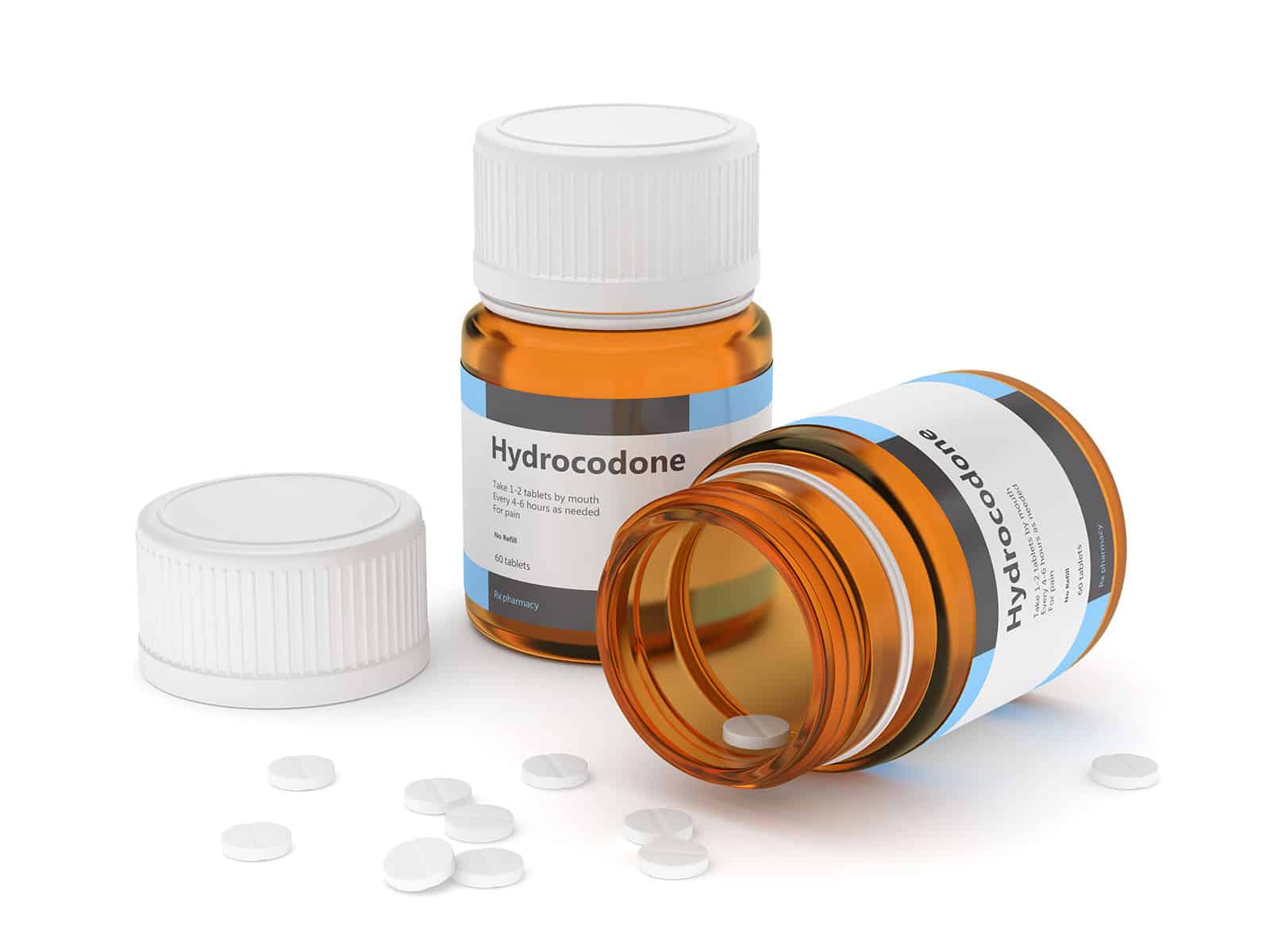Hydrocodone is one of the most commonly prescribed opioids in the United States. It’s often used to provide relief from chronic pain, but it poses a high potential for misuse.
How long hydrocodone stays in the system varies from person to person, and depends on several factors, like age, metabolism, dosage, and frequency of use. Generally, it takes 18 to 24 hours for an average person to clear out most of the hydrocodone from their body.
Because of its powerful effects and high risk for addiction, understanding hydrocodone and how your body reacts to it is essential for patients, family members, and healthcare professionals. Read on to learn more about this effective yet highly addictive painkiller.
What is Hydrocodone?
Hydrocodone is a semi-synthetic opioid drug used to relieve moderate to severe pain. It’s commonly prescribed to provide pain relief after an injury, major surgery, or conditions such as arthritis and cancer when other non-opioid pain medications are ineffective.
This drug is derived from codeine, a natural alkaloid found within the resin of poppy seeds. It comes in both oral tablets and oral solutions.
Many people are familiar with hydrocodone through brand names like Vicodin, Lortab, Lorcet, and Norco, which also contain acetaminophen or ibuprofen. Meanwhile, medications like Hysingla ER and Zohydro ER are extended-release versions of hydrocodone.
Hydrocodone belongs to a class of drugs called opioids, which are known for their soothing and pain-killing effects. Although effective, opioids are also known for their addictive nature, and misuse of these drugs can lead to a harmful dependency.
How Does Hydrocodone Work?
Hydrocodone is taken by mouth and needs to pass through a person’s digestive system to take effect. It starts to relieve pain around 30 minutes to one hour after ingestion. Effects can last for 4 to 24 hours, but the length of time varies depending on the formulation and dosage.
This drug mimics the effect of natural endorphins and affects your brain’s reward center, inducing euphoria and relaxation. It binds to the mu opiate receptor in your central nervous system, blocking pain signals in the brain.
Like most opioids, hydrocodone is metabolized in the liver and excreted by the kidneys. Over time, people who use hydrocodone can develop a tolerance to the drug. It may take them longer to feel relief from chronic pain, or the effects of a dose may not be as strong as before.
How Long Does Hydrocodone Stay in Your System?
It takes at least 18 to 24 hours for a person’s body to clear most of the hydrocodone from its system. After this amount of time, around 90% of the drug has been eliminated from the body.
One way to find out how long a drug lasts is to measure its half-life or the time that it takes for half of the drug to be removed from the body. The average half-life of hydrocodone is 3.8 hours in healthy adults, while that of extended-release hydrocodone is 7 to 9 hours.
It will take several half-lives to fully clear hydrocodone from the body, which can last a whole day for most people. However, certain drug tests may still be able to detect traces of hydrocodone well beyond 24 hours, depending on the area of the body being tested.
How Long Does Hydrocodone Stay in Your Urine?
Traces of hydrocodone are detectable in the urine for around 1 to 4 days after a person uses it. Urine tests are the most common form of drug test. They’re simple to administer, cost-effective and have a longer detection window than other methods.
How Long Does Hydrocodone Stay in Your Blood?
Blood tests can detect hydrocodone up to 24 hours after the last dose. This testing method is more invasive than others. The drug is present at its highest level in the bloodstream around 1.3 hours after intake.
How Long Does Hydrocodone Stay in Your Saliva?
Hydrocodone stays in the saliva and remains detectable for 12 to 36 hours after the last use. Saliva tests are becoming more common due to their less invasive nature, but their window for identifying drug use is shorter than urine tests.
How Long Does Hydrocodone Stay in Your Hair?
In the hair, hydrocodone is detectable for 3 months after a person consumes the drug. Hair tests have the longest detection window because a strand of hair retains information about drug use from the time it was growing.
Factors that Affect How Long Hydrocodone Stays in Your System
People’s bodies process hydrocodone differently, and it may leave one person’s system faster than another because of factors like:
- Age: Younger people generally eliminate toxins faster than older individuals because they have healthier and more efficient organ systems.
- Genetics: Genes influence how people metabolize and react to hydrocodone and their susceptibility to addiction.
- Metabolism: The faster your metabolism is, the quicker your body can process and flush out substances, including hydrocodone.
- Body Composition: Weight and body fat content also play a role in hydrocodone processing, a high dosage relative to your body composition will take longer to eliminate.
- Organ Function: A healthy liver and kidney are important for processing and eliminating substances, any impairment can lengthen hydrocodone’s stay in your system.
- Frequency and Dosage: How long hydrocodone remains in your body will also depend on how long, how often, and how much of it you’ve been taking. A person taking it for years or at high doses will need more time to clear it from their body.
Risks of Hydrocodone Use
All hydrocodone products have a high potential for misuse, and expose you to the risk of dependence, addiction, and overdose. The Drug Enforcement Administration classifies them as Schedule II controlled substances, which means they can only be obtained by prescription.
The extended-release formulations of hydrocodone are specifically developed to be hard to break, crush, or dissolve to prevent abuse. One way to reduce the risk of hydrocodone addiction is to take this medication exactly as prescribed by a doctor or qualified medical professional.
Avoid changing your prescribed hydrocodone dosage or use someone else’s prescription, and reach out to your doctor for a dosage adjustment if your needs change. Understand the risks and signs of hydrocodone addiction to protect yourself and your loved ones.
Side Effects of Hydrocodone
The risk of experiencing side effects and developing a dependence on hydrocodone is lower when it’s taken as prescribed by a doctor, compared to using it without medical supervision.
The most common side effects of hydrocodone are:
- Nausea
- Vomiting
- Constipation
- Abdominal pain
- Drowsiness
- Fatigue
- Shortness of breath
- Anxiety
- Insomnia
- Itchiness
Hydrocodone can potentially cause weak or shallow breathing, so people with asthma and other respiratory conditions should consult their doctor about alternative types of treatment. People with liver damage or kidney impairment should only take a significantly lower dose of the drug.
Combining alcohol with hydrocodone heightens a person’s risk of fatal respiratory depression. If you’re pregnant or breastfeeding, you should avoid taking the drug, as it can be passed through the placenta and breast milk, which could cause respiratory depression or death in infants.
Hydrocodone Withdrawal Symptoms
Withdrawal symptoms from hydrocodone can be mild, moderate, or severe, and they vary from one person to another. You should never stop your medication abruptly without medical supervision, since this can cause serious and life-threatening withdrawal symptoms, such as:
- Fever
- Widened pupils
- Muscle Aches
- Nausea and Vomiting
- Racing heartbeat
- Sweating or chills
- Spikes in blood pressure
- Strong cravings
- Hallucination and paranoia
- Abdominal cramps
- Irritability and restlessness
These symptoms usually begin 6 to 24 hours after the last dose. If you notice these symptoms in yourself, consult a medical professional or contact emergency services as soon as you can.
Treatment Options for Hydrocodone Addiction
If you or someone you know is struggling with hydrocodone addiction, remember that you’re not alone and that help is always available.
Stopping your usage “cold turkey” can result in dangerous withdrawal symptoms, so it’s important to seek the help of a medical professional to start your recovery journey.
You may need to complete a medical detox to remove all harmful substances from your body safely. A trained medical team will help you manage any symptoms and cravings.
Treatment may also involve individual or group therapy sessions to help you manage your mental health and guide you on the path toward addiction recovery. Peer support groups, life skills training programs, and inpatient or outpatient care are additional options to consider.
Leave Addiction Behind With Live Free
If you or a loved one is ready to leave substance addiction behind and start a new life, Live Free Recovery Services is here to help every step of the way. Our treatment facilities in New Hampshire offer a full range of customized care, from detox to inpatient and outpatient rehab.
At Live Free Recovery, we’re committed to providing all the support you need to achieve a healthy, drug-free life, whether it’s in the form of evidence-based therapies or an effective addiction treatment program. Contact Live Free Recovery today and take the first step!


